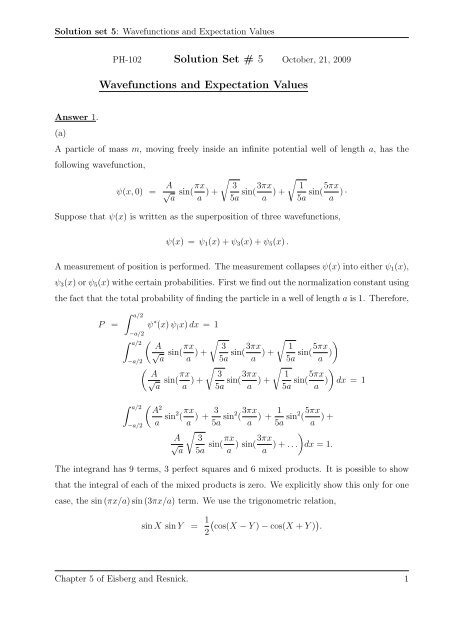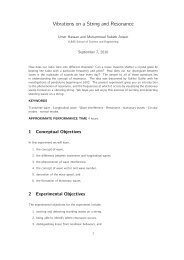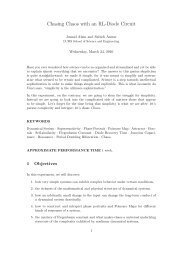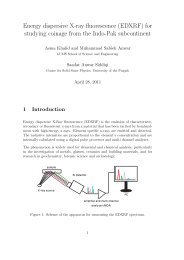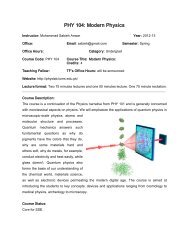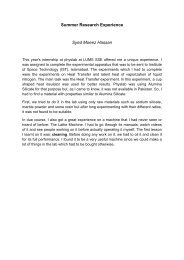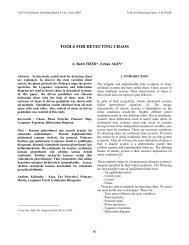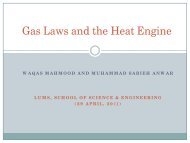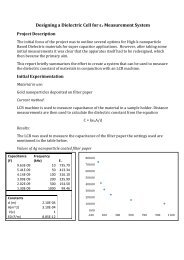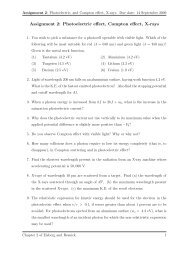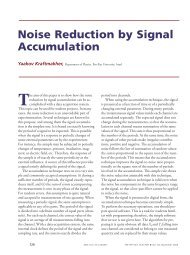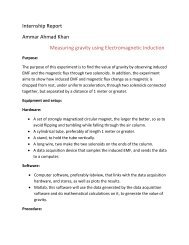Solution Set # 5 Wavefunctions and Expectation Values
Solution Set # 5 Wavefunctions and Expectation Values
Solution Set # 5 Wavefunctions and Expectation Values
Create successful ePaper yourself
Turn your PDF publications into a flip-book with our unique Google optimized e-Paper software.
<strong>Solution</strong> set 5: <strong>Wavefunctions</strong> <strong>and</strong> <strong>Expectation</strong> <strong>Values</strong>PH-102 <strong>Solution</strong> <strong>Set</strong> # 5 October, 21, 2009<strong>Wavefunctions</strong> <strong>and</strong> <strong>Expectation</strong> <strong>Values</strong>Answer 1.(a)A particle of mass m, moving freely inside an infinite potential well of length a, has thefollowing wavefunction,ψ(x, 0) =A √ asin( πxa ) + √35a sin(3πx a ) + √15a sin(5πx a ) ·Suppose that ψ(x) is written as the superposition of three wavefunctions,ψ(x) = ψ 1 (x) + ψ 3 (x) + ψ 5 (x) .A measurement of position is performed. The measurement collapses ψ(x) into either ψ 1 (x),ψ 3 (x) or ψ 5 (x) withe certain probabilities. First we find out the normalization constant usingthe fact that the total probability of finding the particle in a well of length a is 1. Therefore,P =∫ a/2−a/2∫ a/2−a/2ψ ∗ (x) ψ ( x) dx = 1( A√asin( πx√ √ )31a ) + 5a sin(3πx a ) + 5a sin(5πx a )( A√asin( πx√ √ )31a ) + 5a sin(3πx a ) + 5a sin(5πx a ) dx = 1∫ a/2−a/2( A2a sin2 ( πxa ) + 35a sin2 ( 3πxa ) + 15a sin2 ( 5πxa ) +√ )A 3√ a 5a sin(πx a ) sin(3πx a ) + . . . dx = 1.The integr<strong>and</strong> has 9 terms, 3 perfect squares <strong>and</strong> 6 mixed products. It is possible to showthat the integral of each of the mixed products is zero. We explicitly show this only for onecase, the sin (πx/a) sin (3πx/a) term. We use the trigonometric relation,sin X sin Y = 1 2(cos(X − Y ) − cos(X + Y )).Chapter 5 of Eisberg <strong>and</strong> Resnick. 1
<strong>Solution</strong> set 5: <strong>Wavefunctions</strong> <strong>and</strong> <strong>Expectation</strong> <strong>Values</strong>Therefore,∫ a/2−a/2= A2 √ a= A2 √ a= A2 √ a= A2 √ a( √ )A√a 35a sin(πx a ) sin(3πx a ) dx√ ∫ 3 a/2(cos( πx5a −a/2 a − 3πxa ) − cos(πx a + 3πx )a ) √ ∫ 3 a/2(cos( −2πx ) − cos( 4πx )5a −a/2 aa ) √ ∫ 3 a/2(cos( 2πx)5a −a/2 a ) − cos(4πx a )√ ( 3 sin(2πx) 4πxsin(a2π− ) )∣a ∣∣∣a/24π5aaa −a/2= A√ (34π √ sin( 2πx5 a ) − 1 )∣ ∣∣∣a/22 sin(4πx a ) −a/2= A√ 3((sin(π)4π √ + sin(π)) − 1 )52 (sin 2π + sin 2π)= 0.In this way, all the last six terms will be equal to zero, we left with,∫ a/2−a/2∫ a/2−a/2( A2a sin2 ( πxa ) + 35a sin2 ( 3πxa ) + 15a sin2 ( 5πx )a ) dx = 1( A21 − cos( 2πx)a+ 3 1 − cos( 6πx)a+ 1 1 − cos( 12πx)aa 2 5a 2 5a 2)dx = 1A 2a( x2−sin(2πx2 2π aa ))∣ ∣∣∣a/2+ 3 ( x−a/25a 2−sin(6πx2 6π aa ))∣ ∣∣∣a/2+ 1 ( x−a/25a 2−sin(12πx) a2 12πa)∣ ∣∣∣a/2−a/2= 1,where sin( πxa ) ∣ ∣∣∣a/2−a/2= 0,A 2a2a4 + 3 2a5a 4 + 1 2a5a 4 = 1A 22 + 310 + 110 = 1A 2 = 1210A =√65 ,Chapter 5 of Eisberg <strong>and</strong> Resnick. 2
<strong>Solution</strong> set 5: <strong>Wavefunctions</strong> <strong>and</strong> <strong>Expectation</strong> <strong>Values</strong>which is the required normalization constant. Hence the wavefunction in its normalized formis,ψ(x, 0) =√65a sin(πx a ) + √35a sin(3πx a ) + √15a sin(5πx a ) ·(b)As the wavefunction collapses to one of the states, the corresponding eigen energies will bemeasured. In order to calculate the energy of each state, we use Schrodinger’s equation− 22md 2 ψ(x)dx 2 + V (x) ψ(x) = E ψ(x) .Since the particle is free, V (x) = 0, resulting in,− 22md 2 ψ(x)dx 2 = E ψ(x) .For collapse into ψ 1 (x), the measured energy will be E 1 .By comparison,− 22m− 22m(√d 2 6dx 2− 22m√6 π5a a√+ 2 62m 5addxd 2 ψ 1 (x)dx 2)a )5a sin(πx(cos( πx )a )(π 2sin( πx )a 2 a )(√ ) 2 π 2 62ma 2 5a sin(πx a )= E 1 ψ 1 (x)= E 1 ψ 1 (x)= E 1 ψ 1 (x)= E 1 ψ 1 (x)= E 1 ψ 1 (x) 2 π 22ma 2 ψ 1(x) = E 1 ψ 1 (x) .E 1 = 2 π 22ma 2 ·Chapter 5 of Eisberg <strong>and</strong> Resnick. 3
<strong>Solution</strong> set 5: <strong>Wavefunctions</strong> <strong>and</strong> <strong>Expectation</strong> <strong>Values</strong>Similarly for ψ 3 (x),resulting in,− 22m− 22m√35a+ 22m− 22m(√d 2 3dx 23πa√35addxd 2 ψ 3 (x)dx 2)a )5a sin(3πx(cos( 3πx )a )9π 2a 2 (sin( 3πxa ) )(√ )9 2 π 2 32ma 2 5a sin(3πx a )= E 3 ψ 3 (x)= E 3 ψ 3 (x)= E 3 ψ 3 (x)= E 3 ψ 3 (x)= E 3 ψ 3 (x)9 2 π 22ma 2 ψ 3(x) = E 3 ψ 3 (x) ,E 3 = 92 π 22ma 2 ·Similarly, energy corresponding to the next state is,E 5 = 252 π 22ma 2 ·If a measurement is carried out on the system, we would obtain either of these energies withthe corresponding probability P (E n ) . Since the initially given wavefunction contains onlythree eigen states namely ψ 1 (x), ψ 3 (x) <strong>and</strong> ψ 5 (x), the possible energy measurements are,E 1 = π2 22ma 2 ,E 3 = 9π2 22ma 2 ,E 5 = 25π2 22ma 2 ,<strong>and</strong>with the corresponding probabilities,P 1 (E 1 ) =P 3 (E 3 ) =P 5 (E 5 ) =∫ a/2−a/2ψ ∗ 1(x) ψ 1 (x)dx = 3 5∫ a/2−a/2∫ a/2−a/2ψ ∗ 2(x) ψ 2 (x)dx = 310ψ ∗ 3(x) ψ 3 (x)dx = 110 ·Chapter 5 of Eisberg <strong>and</strong> Resnick. 4
<strong>Solution</strong> set 5: <strong>Wavefunctions</strong> <strong>and</strong> <strong>Expectation</strong> <strong>Values</strong>The average or expectation value of the energy will be equal to,< E > = E avg = ∑ nP (E n ) = P 1 E 1 + P 3 E 3 + P 5 E 5(c)= 3 5 E 1 + 310 E 3 + 110 E 5E avg = 29π2 210ma 2 ·The expectation or average value of the energy is not equal to any of the measured values.This is very similar to the throws of a dice. The average value is 3.5 but this is never anoutcome of a single throw!Answer 2.The wavefunction of a free electron is given by,ψ(x) = A sin(2.5 × 10 10 x) .Since x is in meters, the constant 2.5 × 10 10 must have the dimensions of m −1 to keep theargument of the sin function dimensionless. To calculate the required quantities, we startwith the time-independent Schrodinger equation,− 22md 2 ψ(x)dx 2 + V (x) ψ(x) = E ψ(x) .Since the particle is free, V (x) = 0, leading to the simpler form,− 22mMaking use of the given wavefunction, we obtain,d 2 ψ(x)dx 2 = ddx ( ddx (A sin(2.5 × 1010 x)))d 2 ψ(x)dx 2 = E ψ(x) . (1)= (2.5 × 10 10 ) ddx (A cos(2.5 × 1010 x))= − (2.5 × 10 10 )(2.5 × 10 10 ) A sin(2.5 × 10 10 x)d 2 ψ(x)= − (2.5 × 10 10 ) 2 ψ(x) ,dx 2<strong>and</strong> the R.H.S becomes,− 22md 2 ψ(x)dx 2= 22m (2.5 × 1010 ) 2 ψ(x) ,Chapter 5 of Eisberg <strong>and</strong> Resnick. 5
<strong>Solution</strong> set 5: <strong>Wavefunctions</strong> <strong>and</strong> <strong>Expectation</strong> <strong>Values</strong>comparing with the R.H.S of expression (1), we obtain, 22m (2.5 × 1010 ) 2 ψ(x) = E ψ(x)E = (2.5 × 1010 ) 2 22mwhich is the required energy of the free electron. In case of the free particle, the total energyis just equal to the kinetic energy <strong>and</strong> contribution of the potential energy is zero.(a)To compute the momentum of free electron, we use,p2Total Energy = E = K.E =2mp 2 = 2mEThis is the momentum of the free electron.(b)The wavelength of the free electron is,(c)λ = h p =h(2.5 × 10 10 ) h2π=p = ± √ 2mE√= ± 2m (2.5 × 1010 ) 2 22m= ±(2.5 × 10 10 ) (Kg m s −1 ).2π(2.5 × 10 10 ) = 2.5 × 10−10 = 2.5 Å .As we have find out the exact value of momentum, therefore the uncertainty in momentumis zero. On the other h<strong>and</strong>, uncertainty in position will be infinite (∆x = ∞).Answer 3.(a)For the problem of the finite square well potential, when the total energy is greater than thepotential energy, (E > V o ), the wavefunction will display an oscillating pattern. This canbe seen from the Schrodinger equation,,d 2 ψdx 2= 2m 2 (V − E o) ψ .This equation show that ψ(x) will be concave downwards when ψ is positive <strong>and</strong> concaveupwards when ψ is negative. The bending is sharper when |V − E o | is larger; this is theChapter 5 of Eisberg <strong>and</strong> Resnick. 6
<strong>Solution</strong> set 5: <strong>Wavefunctions</strong> <strong>and</strong> <strong>Expectation</strong> <strong>Values</strong>region labeled II. In regions I <strong>and</strong> III, the bending is gentler, the maximum amplitude ishigher <strong>and</strong> the separation between the nodes is also larger._ I0.0003_ II_ III0.00020.0001-4 -2 2 4-0.0001-0.0002-0.0003It is also clear from the figure that the behavior of wavefunction is symmetric about x = 0<strong>and</strong> identical in regions I <strong>and</strong> III.(b)The energy will not be quantized because the particle is not confined <strong>and</strong> is free to movein any direction. The energy is only quantized when the particle is confined within someregion <strong>and</strong> its energy is less than the barrier potential (E < V o ).(c)Solving equation (1), the wavefunction isψ(x) = A exp(ikx) + B exp(−ikx) .The value of the potential is non zero in region I (x < −a/2) <strong>and</strong> III (x > a/2), so the wavenumbers in these two regions will be,k =√2m(E − Vo )·Chapter 5 of Eisberg <strong>and</strong> Resnick. 7
<strong>Solution</strong> set 5: <strong>Wavefunctions</strong> <strong>and</strong> <strong>Expectation</strong> <strong>Values</strong>In region II, the wavenumber will be,k =√2mE·Answer 4.Correct option: EWhen an electron is in the superposition of two or more wavefunctions <strong>and</strong> you make ameasurement of the energy of this electron, then the wavefunction collapses into an energyeigenstate. The probability of finding energy E 1 will be simply equal to modulus squaredof the amplitude accompanying ψ 1 (x). So, the probability of obtaining the value E 1 is 9/25<strong>and</strong> the probability of obtaining the value E 2 is 16/25.Answer 5.Correct option: AAfter the first measurement, you are again interested in measuring the energy of the sameelectron. Since the wavefunction is already collapsed <strong>and</strong> the state becomes an eigen stateof energy, the consecutive measurement will yield same value of energy as in the first case,(with probability one).Answer 6.Correct option: AAfter precisely measuring the position, if you measure the energy again, you will get thesame value of energy.Chapter 5 of Eisberg <strong>and</strong> Resnick. 8


